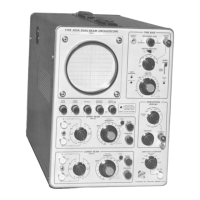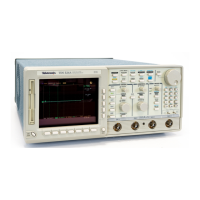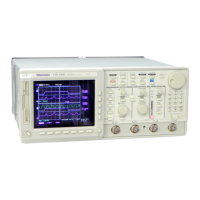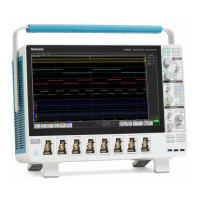Circuit Description— Type 544/RM544
—1850-volt output of the supply, amplifies any errors and
uses the amplified error voltage to adjust the screen voltage
of Hartley oscillator V800. If the —1850-volt output changes,
the change is detected at the grid of V814B. The detected
error is amplified by V814B and V814A. The error signal at
the plate of V814A is direct coupled to the screen of V800
by making the plate-load resistor of V814A serve as the
screen-dropping resistor for V800. Any change in the —1850-
volt output thus changes the screen voltage of V800 and the
amplitude of the 50-kc oscillations. R840 provides a means of
controlling the high-voltage output through controlling oscil
lation amplitude.
Crt Grid Supply. The approximately —1950-volt output of
the high-voltage power supply is the rectified output of one
of the two high-voltage secondaries on T801. To provide de
coupled unblanking signals to the crt grid, the crt grid supply
is floating (the dc voltage levels on the components shift in
accordance with the unblanking signals). The positive side; of
the crt grid supply is returned to the —150-volt supply
through the unblanking cathode-follower load resistor of the
selected sweep generator and through R831 and R832. The
negative side of the crt grid supply is applied through the
INTENSITY control to the crt grid.
At the fastest sweep rates, the stray capacitance of the
floating crt grid circuit makes it difficult for the crt grid to
rise fast enough to unblank the crt in the required time. An
isolation network consisting of R827, R828, C828, C829, and
C830 isolates the capacitive loading. By this arrangement,
the fast leading edge of the unblanking pulse is coupled
through C830 and C828 to the grid of the crt. For short-
duration unblanking pulses, such as those that occur at the
fastest sweep rates, the dc levels on the rectifier and second
ary winding are not appreciably affected. Longer unblonk-
ing pulses, such as those that occur at the slower sweep rates,
charge the stray capacitance in the —1950-volt output
through R827. This pulls up the floating crt grid circuit and
holds the crt grid at the unblanked potential for the duration
of the unblanking pulse.
+ 8150- and — 1850-Volt Outputs. Both the +8150- and
—1850-volt outputs are derived from the same secondary
winding on T801. The full secondary voltage of approx
imately 2900 volts is applied to a voltage tripler consisting
of rectifiers V832, V842, and V852 and associated capacitors.
A tap on the secondary provides the input for half-wave rec
tifier V862 in the —1850-volt output. Both outputs are ref
erenced to the regulated + 350-volt supply through a volt
age divider network. The + 8150-volt output is connected to
the crt post-deflection-accelerator anode and the —1850-volt
output is connected to the crt cathode, providing a total ac
celerating voltage of 10,000 volts.
Crt Circuit Controls and Connectors. Optimum size and
shape of the flourescent spot on the crt is obtained by adjust
ing the front-panel FOCUS and ASTIGMATISM controls.
FOCUS control R846 provides the correct voltage for the sec
ond anode (focus ring) in the crt. Proper voltage for the third
anode is obtained by adjusting ASTIGMATISM control R864.
In order to obtain optimum spot size and shape, both the
FOCUS and ASTIGMATISM controls are adjusted to provide
the proper electronic lens configuration in the region of the
second and third anodes of the crt. Spot intensity is adjusted
by means of front-panel INTENSITY control R826. Varying
the INTENSITY control changes the voltage on the crt grid,
which in turn varies the density of the electron stream. Inter
nal GEOMETRY control R861 adjusts the isolation shield volt
age in the crt, and is adjusted to minimize "bowing" or "tilting"
of the display. Front-panel TRACE ROTATION control R778
permits minor adjustments in trace orientation. By adjusting
the TRACE ROTATION control, the trace can be made par
allel with the horizontal lines on the graticule, eliminating the
need to physically turn the crt to correct for minor deviations
of the trace from the horizontal.
An input binding post on the rear panel of the Type 544
provides an input for externally modulating the crt cathode.
The input binding post is normally grounded by a link. If it
is desired to intensity modulate the display from an external
source, the link is opened, and the modulating signal is
coupled to the crt cathode through C858.
When the Type 544 is used with a multi-channel vertical
plug-in preamplifier that provides dual-trace chopped blank
ing pulses, the blanking pulses are applied to rear-panel CRT
CATHODE SELECTOR switch SW858. With the vertical plug
in preamplifier operating in the chopped mode and SW858
set to the CHOPPED BLANKING position, a positive pulse of
approximately 20-volts amplitude is applied through C858 to
the cathode of the crt. At normal intensity levels, this pulse
is sufficient to cut off the crt during the time the amplifier
channels in the vertical plug-in preamplifiers are being
switched.
Vertical Amplifier System
The vertical amplifier system in the Type 544 consists of
an appropriate vertical plug-in preamplifier, a push-pull
cathode-follower input stage, a push-pull transistorized delay
line driver, a delay line, and a push-pull transistorized output
amplifier. In addition, the trigger-pickoff circuit functions as
a part of the vertical amplifier by providing reverse termina
tion for the delay line.
Vertical Input Amplifier. The push-pull output of the verti
cal plug-in preamplifier, with a fixed dc level of approxi
mately + 67.5 volts, is applied to the input of the vertical
amplifier through terminals 1 and 3 of the plug-in connector.
Transient-response compensation switch SW1000, capacitor
C l000, and resistor R1000 at the input of the vertical ampli
fier compensate for the difference in transient response that
exists between different models of vertical plug-in preampli
fiers. SW1000 is actuated by a mechanical sensing device
when the plug-in unit is inserted into the oscilloscope, and
requires no attention on the part of the operator.
R1001 and R1011, in series with the grids of the push-pull
cathode-follower stage, are parasitic suppressors. Input cath
ode followers V1003A and V1003B are the two halves of a
12AT7 twin triode. The cathodes of the cathode followers are
returned to ground through vertical dc balance control R1004,
which is adjusted to equalize the dc voltage (about +68.5
volts) on the bases of delay-line driver transistors Q1014 and
Q1024. The heaters of V I003 are operated as part of the
series string which receives power from the + 100-volt dc
supply. The use of dc on the heaters prevents changes in
line voltage from affecting the gain of the vertical amplifier.
The balanced delay-line driver stage is a push-pull ampli
fier with an adjustable vertical gain control (R1017) con
nected in the emitter circuit of the two transistors. Gain is
adjusted by controlling the amount of degeneration in the
3-5
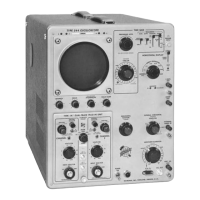
